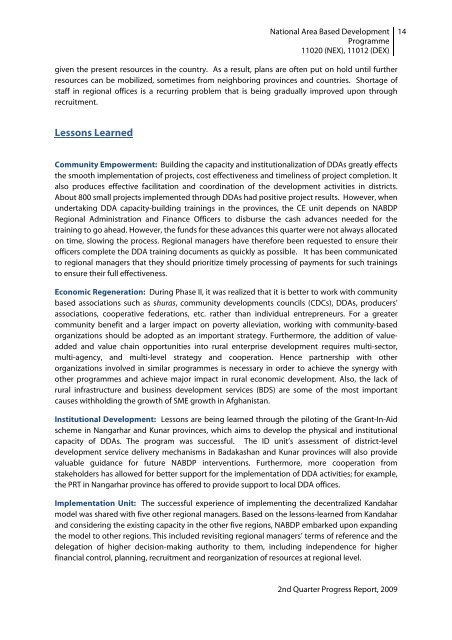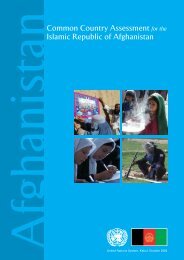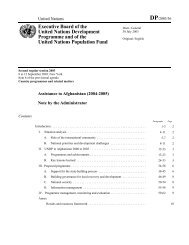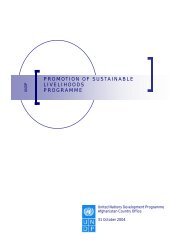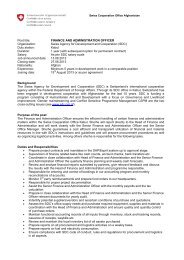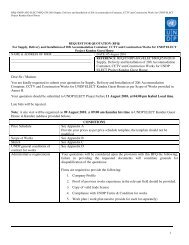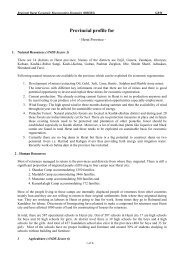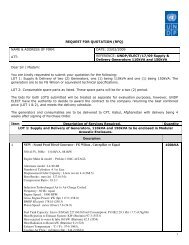(NABDP) 2nd Quarter Project Progress Report â 2009 - UNDP ...
(NABDP) 2nd Quarter Project Progress Report â 2009 - UNDP ...
(NABDP) 2nd Quarter Project Progress Report â 2009 - UNDP ...
You also want an ePaper? Increase the reach of your titles
YUMPU automatically turns print PDFs into web optimized ePapers that Google loves.
National Area Based Development<br />
Programme<br />
11020 (NEX), 11012 (DEX)<br />
14<br />
given the present resources in the country. As a result, plans are often put on hold until further<br />
resources can be mobilized, sometimes from neighboring provinces and countries. Shortage of<br />
staff in regional offices is a recurring problem that is being gradually improved upon through<br />
recruitment.<br />
Lessons Learned<br />
Community Empowerment: Building the capacity and institutionalization of DDAs greatly effects<br />
the smooth implementation of projects, cost effectiveness and timeliness of project completion. It<br />
also produces effective facilitation and coordination of the development activities in districts.<br />
About 800 small projects implemented through DDAs had positive project results. However, when<br />
undertaking DDA capacity-building trainings in the provinces, the CE unit depends on <strong>NABDP</strong><br />
Regional Administration and Finance Officers to disburse the cash advances needed for the<br />
training to go ahead. However, the funds for these advances this quarter were not always allocated<br />
on time, slowing the process. Regional managers have therefore been requested to ensure their<br />
officers complete the DDA training documents as quickly as possible. It has been communicated<br />
to regional managers that they should prioritize timely processing of payments for such trainings<br />
to ensure their full effectiveness.<br />
Economic Regeneration: During Phase II, it was realized that it is better to work with community<br />
based associations such as shuras, community developments councils (CDCs), DDAs, producers’<br />
associations, cooperative federations, etc. rather than individual entrepreneurs. For a greater<br />
community benefit and a larger impact on poverty alleviation, working with community-based<br />
organizations should be adopted as an important strategy. Furthermore, the addition of valueadded<br />
and value chain opportunities into rural enterprise development requires multi-sector,<br />
multi-agency, and multi-level strategy and cooperation. Hence partnership with other<br />
organizations involved in similar programmes is necessary in order to achieve the synergy with<br />
other programmes and achieve major impact in rural economic development. Also, the lack of<br />
rural infrastructure and business development services (BDS) are some of the most important<br />
causes withholding the growth of SME growth in Afghanistan.<br />
Institutional Development: Lessons are being learned through the piloting of the Grant-In-Aid<br />
scheme in Nangarhar and Kunar provinces, which aims to develop the physical and institutional<br />
capacity of DDAs. The program was successful. The ID unit’s assessment of district-level<br />
development service delivery mechanisms in Badakashan and Kunar provinces will also provide<br />
valuable guidance for future <strong>NABDP</strong> interventions. Furthermore, more cooperation from<br />
stakeholders has allowed for better support for the implementation of DDA activities; for example,<br />
the PRT in Nangarhar province has offered to provide support to local DDA offices.<br />
Implementation Unit: The successful experience of implementing the decentralized Kandahar<br />
model was shared with five other regional managers. Based on the lessons-learned from Kandahar<br />
and considering the existing capacity in the other five regions, <strong>NABDP</strong> embarked upon expanding<br />
the model to other regions. This included revisiting regional managers’ terms of reference and the<br />
delegation of higher decision-making authority to them, including independence for higher<br />
financial control, planning, recruitment and reorganization of resources at regional level.<br />
<strong>2nd</strong> <strong>Quarter</strong> <strong>Progress</strong> <strong>Report</strong>, <strong>2009</strong>


